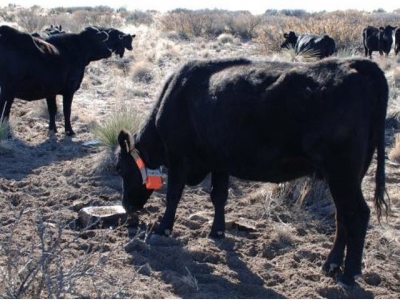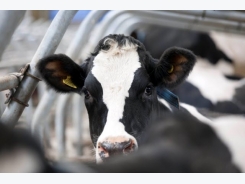Manage grazing behavior

INFLUENCING THE GRAZING HABITS OF CATTLE CAN LEAD TO MORE UNIFORM FORAGE USE.
Cows wear a GPS-embedded collar for tracking where they graze within a pasture. Jay Rodman
Left to their own devices, cattle frequently graze those areas of a pasture where grass is most succulent and most easily within reach. In pastures with both uplands and lowlands, this often results in a patchwork of overgrazed areas interspersed with undergrazed spots, where forage grows rank and increasingly less palatable.
Managing grazing behavior to make better use of all forage offers multiple benefits.
“With uniform grazing, you might be able to run more cattle or extend the grazing season,” says Mitchell Stephenson, range and forage specialist at the University of Nebraska. “By reducing overgrazing in select areas, the overall health trend of the pasture would go up over time, leading to improved water infiltration, more effective carbon sequestration, and improved habitat for birds and wildlife.”
Physically controlling grazing distribution with crossfencing works best, but it is not always practical, especially in very large pastures with rough terrain and limited availability of water.
“There are several management options that can improve livestock distribution and grazing uniformity,” says Stephenson. “Most of these either change the attributes of the pasture, or they serve to modify animal behavior.”
Before making changes, however, monitor present grazing patterns to see whether or not modifications would, indeed, be helpful.
“If your pastures have both lowland and upland areas, look for places that get grazed a lot and for areas that don’t,” he says. “Grazing will usually be greater on flat riparian areas near streams. That’s because these areas provide high-quality vegetation, shade, and water throughout the growing season. The upland areas tend to have less grazing because of lower forage quality and quantity and because of steeper slopes and greater climbs.”
While monitoring existing grazing patterns, evaluate the mosaic of diversity created by grazed areas interspersed with ungrazed places. A moderate patchwork effect in a pasture has value. Lightly grazed areas of taller grasses interspersed with closely grazed patches offer diverse habit for birds and other wildlife.
“While healthy, sustainable environments are the goal, managing rangelands so that some small areas receive a higher degree of use may improve the overall diversity and health of a grassland,” explains Stephenson.
After evaluating the grazing patterns at play, envision the changes you would like to see in the vigor and stature of plants across the landscape. From this, set grazing objectives by imagining the changes needed in grazing distribution that would accomplish your goals for the ecosystem.
6 MANAGEMENT TIPS
Following are six tips for managing grassland resources that might modify grazing behavior of cattle in productive ways.
1. INCREASE OR RESTRICT AVAILABILITY OF WATER.
“Increasing the number of watering locations will aid in distributing grazing more evenly across a landscape,” says Stephenson. “Additionally, strategic placement of water and limits on when water is available in specific areas of large pastures may provide opportunities to rotate livestock without fencing.”
2. CHANGE SEASON OF USE.
Either an early summer or a fall grazing of certain pastures may result in more uniform grazing distribution of cattle than grazing in mid- or late summer. In pastures with both uplands and subirrigated lowlands, forage quality is more uniform in early summer when upland grasses are green and lush like the grass in the lowland areas. By midsummer, the upland grasses tend to become dry and dormant, causing cattle to overgraze the still-green lowland areas.
“Grazing pastures in the late fall or winter may improve distribution. That’s because vegetation is dormant during this time of the year, and quality of vegetation is typically more uniform across ecological sites,” says Stephenson. “As a result, cattle will be less likely to focus their grazing on areas that would typically be preferred at other times of the year.”
3. PLACE SUPPLEMENTS IN STRATEGIC LOCATIONS.
Placing salt, mineral, and protein supplements in areas typically undergrazed can draw cattle into these areas. “Research has suggested that sweetened low-moisture block protein supplements may be more effective at altering distribution when compared with range cake or conventional dry mineral mixes,” says Stephenson.
However, the effectiveness of supplements in drawing cattle to underused areas decreases as terrain becomes rougher and steeper. Cattle tend to ignore the blocks, too, when grass is lush.
4. HERD CATTLE TO UNDERGRAZED AREAS.
Using low-stress, pressure-and-release herding methods, cattle can be conditioned to move into undergrazed areas.
5. USE HERDING ALONG WITH SUPPLEMENTS.
The combination can be more effective than the use of herding or supplements alone.
“In one study in New Mexico, low-stress herding used in combination with strategic placement of protein blocks succeeded in focusing grazing on underused areas 1 to 2 miles from water in the late fall and early winter when grass was dormant,” says Stephenson.
“We conducted the study in rough terrain where cattle had to travel up steep slopes to get to the supplement,” he says. “We placed the sweetened protein blocks in strategic locations where cattle were not grazing.”
Every two days after livestock had finished drinking, horseback riders went out at midday and calmly moved animals back to graze the elevated areas where protein blocks were located. Cattle often moved to supplement locations on their own.
“In the targeted area, we were able to reduce the amount of current-year standing biomass by about 40% to 50%,” says Stephenson. “Thus, the risk of fire was reduced, which was our goal.”
6. GENETICALLY SELECT FOR GRAZERS OF DIVERSE (INCLUDING ROUGH) TOPOGRAPHY.
Ongoing research has positively correlated differences in individual animals’ DNA with differences in their tendencies to graze far from water and to navigate steep terrain.
“This suggests that by selecting replacement heifers from such cows, you can develop a herd that is adapted to grazing in a challenging environment, which includes rough terrain,” says Stephenson.
Có thể bạn quan tâm
Phần mềm

Phối trộn thức ăn chăn nuôi

Pha dung dịch thủy canh

Định mức cho tôm ăn

Phối trộn phân bón NPK

Xác định tỷ lệ tôm sống

Chuyển đổi đơn vị phân bón

Xác định công suất sục khí

Chuyển đổi đơn vị tôm

Tính diện tích nhà kính

Tính thể tích ao hồ



 Embryo Transfer Technology revolutionises cattle breeding
Embryo Transfer Technology revolutionises cattle breeding  Combatting inefficient nitrogen use in dairy cows
Combatting inefficient nitrogen use in dairy cows